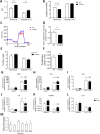The hypoxia-sensor carbonic anhydrase IX affects macrophage metabolism, but is not a suitable biomarker for human cardiovascular disease
- PMID: 33432108
- PMCID: PMC7801702
- DOI: 10.1038/s41598-020-79978-5
The hypoxia-sensor carbonic anhydrase IX affects macrophage metabolism, but is not a suitable biomarker for human cardiovascular disease
Abstract
Hypoxia is prevalent in atherosclerotic plaques, promoting plaque aggravation and subsequent cardiovascular disease (CVD). Transmembrane protein carbonic anhydrase IX (CAIX) is hypoxia-induced and can be shed into the circulation as soluble CAIX (sCAIX). As plaque macrophages are hypoxic, we hypothesized a role for CAIX in macrophage function, and as biomarker of hypoxic plaque burden and CVD. As tumor patients with probable CVD are treated with CAIX inhibitors, this study will shed light on their safety profile. CAIX co-localized with macrophages (CD68) and hypoxia (pimonidazole), and correlated with lipid core size and pro-inflammatory iNOS+ macrophages in unstable human carotid artery plaques. Although elevated pH and reduced lactate levels in culture medium of CAIX knock-out (CAIXko) macrophages confirmed its role as pH-regulator, only spare respiratory capacity of CAIXko macrophages was reduced. Proliferation, apoptosis, lipid uptake and expression of pro- and anti-inflammatory genes were not altered. Plasma sCAIX levels and plaque-resident CAIX were below the detection threshold in 50 and 90% of asymptomatic and symptomatic cases, respectively, while detectable levels did not associate with primary or secondary events, or intraplaque hemorrhage. Initial findings show that CAIX deficiency interferes with macrophage metabolism. Despite a correlation with inflammatory macrophages, plaque-resident and sCAIX expression levels are too low to serve as biomarkers of future CVD.
Conflict of interest statement
The authors declare no competing interests.
Figures




References
Publication types
MeSH terms
Substances
LinkOut - more resources
Full Text Sources
Other Literature Sources
Molecular Biology Databases
Research Materials

